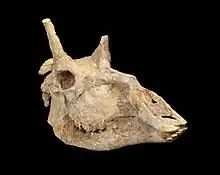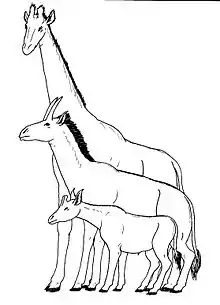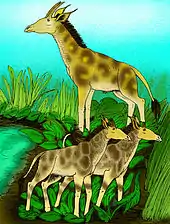Samotherium
Samotherium ("beast of Samos") is an extinct genus of Giraffidae from the Miocene and Pliocene of Eurasia and Africa. Samotherium had two ossicones on its head, and long legs. The ossicones usually pointed upward, and were curved backwards, with males having larger, more curved ossicones, though in the Chinese species, S. sinense, the straight ossicones point laterally, not upwards. The genus is closely related to Shansitherium. Fossil evidence suggests that Samotherium had a rounded muzzle, which would suggest a grazing lifestyle and a habitat composed of grassland.[1]
| Samotherium | |
|---|---|
 | |
| Samotherium skull | |
| Scientific classification | |
| Kingdom: | Animalia |
| Phylum: | Chordata |
| Class: | Mammalia |
| Order: | Artiodactyla |
| Family: | Giraffidae |
| Genus: | †Samotherium |
| Species | |
| |
According to biologist Richard Ellis the skull of a Samotherium is portrayed on an ancient Greek vase as a monster that Heracles is fighting.[2]
Description


A 2015 study found that Samotherium had a neck intermediate in length between the giraffe and the okapi, judging from examination of specimens of S. major from Greece.[3]
References
- Walker, Cyril; Ward, David (2002). Fossils (2nd American ed.). Dorling Kindersley. p. 280. ISBN 0-7894-8984-8.
- Ellis, Richard (2004). No Turning Back: The Life and Death of Animal Species. New York: Harper Perennial. pp. 6. ISBN 0-06-055804-0.
- Danowitz, Melinda; Domalski, Rebecca; Solounias, Nikos (1 November 2015). "The cervical anatomy of Samotherium, an intermediate-necked giraffid". Open Science. The Royal Society. 2 (11): 150521. doi:10.1098/rsos.150521. PMC 4680625. PMID 26716010.
